Prafull Sharma
ZeST: Zero-Shot Material Transfer from a Single Image
Apr 09, 2024Abstract:We propose ZeST, a method for zero-shot material transfer to an object in the input image given a material exemplar image. ZeST leverages existing diffusion adapters to extract implicit material representation from the exemplar image. This representation is used to transfer the material using pre-trained inpainting diffusion model on the object in the input image using depth estimates as geometry cue and grayscale object shading as illumination cues. The method works on real images without any training resulting a zero-shot approach. Both qualitative and quantitative results on real and synthetic datasets demonstrate that ZeST outputs photorealistic images with transferred materials. We also show the application of ZeST to perform multiple edits and robust material assignment under different illuminations. Project Page: https://ttchengab.github.io/zest
Alchemist: Parametric Control of Material Properties with Diffusion Models
Dec 05, 2023Abstract:We propose a method to control material attributes of objects like roughness, metallic, albedo, and transparency in real images. Our method capitalizes on the generative prior of text-to-image models known for photorealism, employing a scalar value and instructions to alter low-level material properties. Addressing the lack of datasets with controlled material attributes, we generated an object-centric synthetic dataset with physically-based materials. Fine-tuning a modified pre-trained text-to-image model on this synthetic dataset enables us to edit material properties in real-world images while preserving all other attributes. We show the potential application of our model to material edited NeRFs.
Materialistic: Selecting Similar Materials in Images
May 22, 2023Abstract:Separating an image into meaningful underlying components is a crucial first step for both editing and understanding images. We present a method capable of selecting the regions of a photograph exhibiting the same material as an artist-chosen area. Our proposed approach is robust to shading, specular highlights, and cast shadows, enabling selection in real images. As we do not rely on semantic segmentation (different woods or metal should not be selected together), we formulate the problem as a similarity-based grouping problem based on a user-provided image location. In particular, we propose to leverage the unsupervised DINO features coupled with a proposed Cross-Similarity module and an MLP head to extract material similarities in an image. We train our model on a new synthetic image dataset, that we release. We show that our method generalizes well to real-world images. We carefully analyze our model's behavior on varying material properties and lighting. Additionally, we evaluate it against a hand-annotated benchmark of 50 real photographs. We further demonstrate our model on a set of applications, including material editing, in-video selection, and retrieval of object photographs with similar materials.
SAR-to-EO Image Translation with Multi-Conditional Adversarial Networks
Jul 26, 2022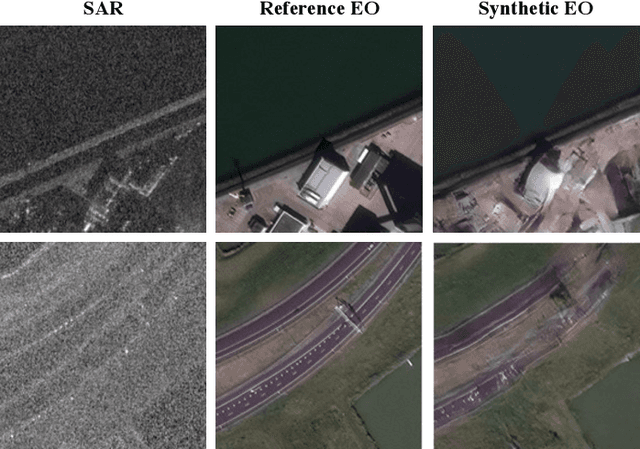
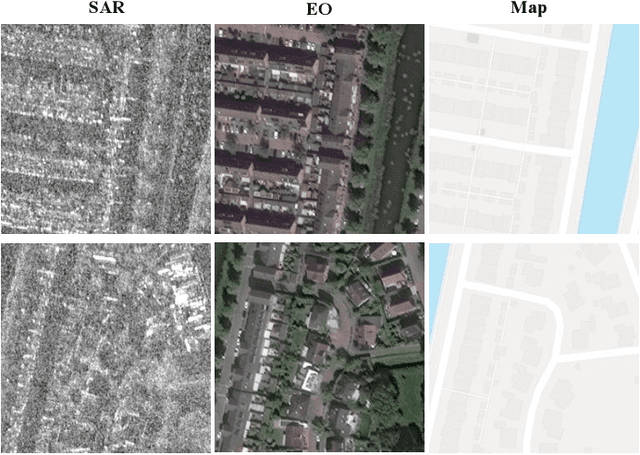
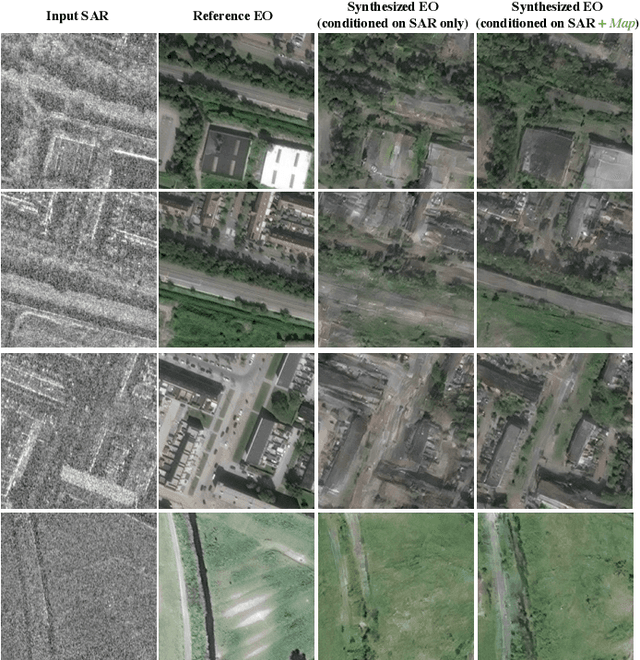
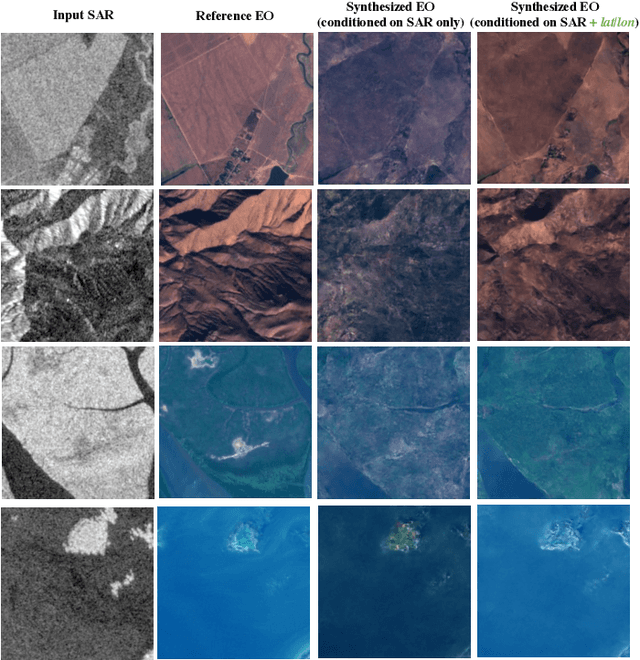
Abstract:This paper explores the use of multi-conditional adversarial networks for SAR-to-EO image translation. Previous methods condition adversarial networks only on the input SAR. We show that incorporating multiple complementary modalities such as Google maps and IR can further improve SAR-to-EO image translation especially on preserving sharp edges of manmade objects. We demonstrate effectiveness of our approach on a diverse set of datasets including SEN12MS, DFC2020, and SpaceNet6. Our experimental results suggest that additional information provided by complementary modalities improves the performance of SAR-to-EO image translation compared to the models trained on paired SAR and EO data only. To best of our knowledge, our approach is the first to leverage multiple modalities for improving SAR-to-EO image translation performance.
Seeing 3D Objects in a Single Image via Self-Supervised Static-Dynamic Disentanglement
Jul 22, 2022



Abstract:Human perception reliably identifies movable and immovable parts of 3D scenes, and completes the 3D structure of objects and background from incomplete observations. We learn this skill not via labeled examples, but simply by observing objects move. In this work, we propose an approach that observes unlabeled multi-view videos at training time and learns to map a single image observation of a complex scene, such as a street with cars, to a 3D neural scene representation that is disentangled into movable and immovable parts while plausibly completing its 3D structure. We separately parameterize movable and immovable scene parts via 2D neural ground plans. These ground plans are 2D grids of features aligned with the ground plane that can be locally decoded into 3D neural radiance fields. Our model is trained self-supervised via neural rendering. We demonstrate that the structure inherent to our disentangled 3D representation enables a variety of downstream tasks in street-scale 3D scenes using simple heuristics, such as extraction of object-centric 3D representations, novel view synthesis, instance segmentation, and 3D bounding box prediction, highlighting its value as a backbone for data-efficient 3D scene understanding models. This disentanglement further enables scene editing via object manipulation such as deletion, insertion, and rigid-body motion.
What You Can Learn by Staring at a Blank Wall
Aug 30, 2021

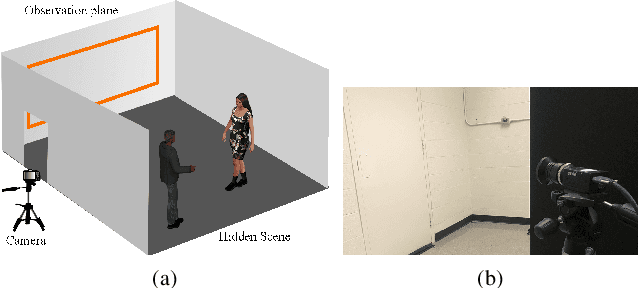

Abstract:We present a passive non-line-of-sight method that infers the number of people or activity of a person from the observation of a blank wall in an unknown room. Our technique analyzes complex imperceptible changes in indirect illumination in a video of the wall to reveal a signal that is correlated with motion in the hidden part of a scene. We use this signal to classify between zero, one, or two moving people, or the activity of a person in the hidden scene. We train two convolutional neural networks using data collected from 20 different scenes, and achieve an accuracy of $\approx94\%$ for both tasks in unseen test environments and real-time online settings. Unlike other passive non-line-of-sight methods, the technique does not rely on known occluders or controllable light sources, and generalizes to unknown rooms with no re-calibration. We analyze the generalization and robustness of our method with both real and synthetic data, and study the effect of the scene parameters on the signal quality.
Computational Mirrors: Blind Inverse Light Transport by Deep Matrix Factorization
Dec 05, 2019



Abstract:We recover a video of the motion taking place in a hidden scene by observing changes in indirect illumination in a nearby uncalibrated visible region. We solve this problem by factoring the observed video into a matrix product between the unknown hidden scene video and an unknown light transport matrix. This task is extremely ill-posed, as any non-negative factorization will satisfy the data. Inspired by recent work on the Deep Image Prior, we parameterize the factor matrices using randomly initialized convolutional neural networks trained in a one-off manner, and show that this results in decompositions that reflect the true motion in the hidden scene.
* 14 pages, 5 figures, Advances in Neural Information Processing Systems 2019
 Add to Chrome
Add to Chrome Add to Firefox
Add to Firefox Add to Edge
Add to Edge